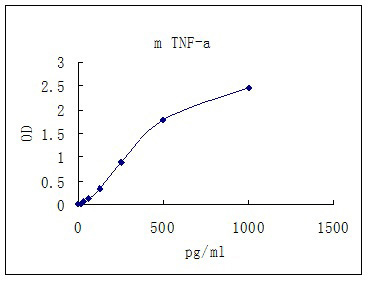Mouse TNF-a ELISA Kit (48-well)
CNY 2,630.00
Specifications
| Product Data | |
| Description | Mouse TNF-a ELISA Kit (48-well) |
| Size | 1 x 48 wells |
| Format | 48-well strip plate |
| Assay Type | Solid Phase Sandwich ELISA |
| Assay Length | 3 hour |
| Signal | Colorimetric |
| Curve Range | 0.02 - 1.0 ng/mL |
| Sample Type | Cell culture supernatant, serum, plasma (EDTA, citrate, heparin) |
| Sample Volume | 20 uL |
| Specificity | Natural and recombinant Mouse TNF-a Ligand |
| Sensitivity | 7pg/mL |
| Reactivity | Mouse |
| Interference | No significant interference observed with available related molecules. |
| Components | Aluminium pouches with a Microwell Plate coated with antibody to mouse TNF-a (8x6) 1 vial mouse TNF-a Standard lyophilized, 1000 pg/ml upon reconstitution 1 vial concentrated Biotin-Conjugate anti-mouse TNF-a antibody 1 vial Streptavidin-HRP solution 1 bottle Standard /sample Diluent 1 bottle Biotin-Conjugate antibody Diluent 1 bottle Streptavidin-HRP Diluent 1 bottle Wash Buffer Concentrate 20x (PBS with 1% Tween-20) 1 vial Substrate Solution 1 vial Stop Solution 2 pieces Adhesive Films package insert |
| Background | The prototype ligand of theTNFsuperfamily, TNF-./TNFSF1A, is a pleiotropic cytokine that plays a central role in inflammation and apoptosis .TNF-. is produced by activated macrophages and other cell types including T and B cells, NK cells, LAK cells, astrocytes, endothelial cells, smooth muscle cells and some tumor cells . Mouse TNF-. cDNA encodes a 235 amino acid (aa) residue type II membrane protein . The 156 aa residue soluble TNF-. is released from the C-terminus of the membrane-anchored TNF-. by proteolytic cleavage by a matrix metalloprotease . The membrane-anchored form of TNF-. has been shown to have lytic activity and may also have an important role in intercellular communication . The biologically active TNF-. has been shown to exist as a trimer .TNF-. is reported to promote inflammatory cell infiltration by upregulating leukocyte adhesion molecules on endothelial cells, serve as a chemotactic agent for monocytes, and activate phagocyte killing mechanisms . Deficiencies in either TNF-. or its receptors can increase susceptibility to infection by intracellular pathogens . TNF- may also play a role in lymphoid tissue development. Knockout mice lack splenic B cell follicles and the ability to form germinal centers . Other potential physiological roles for TNF-. and its receptors include regulating the differentiation of hematopoietic stem and progenitor cells . |
| Gene Symbol | Tnf |
| Standard Curve |

Representative standard curve for TNF-a ELISA. TNF-a was diluted in serial two-fold steps in Sample Diluent.
|
Documents
| Product Manuals |


 United States
United States
 Germany
Germany
 Japan
Japan
 United Kingdom
United Kingdom
 China
China

